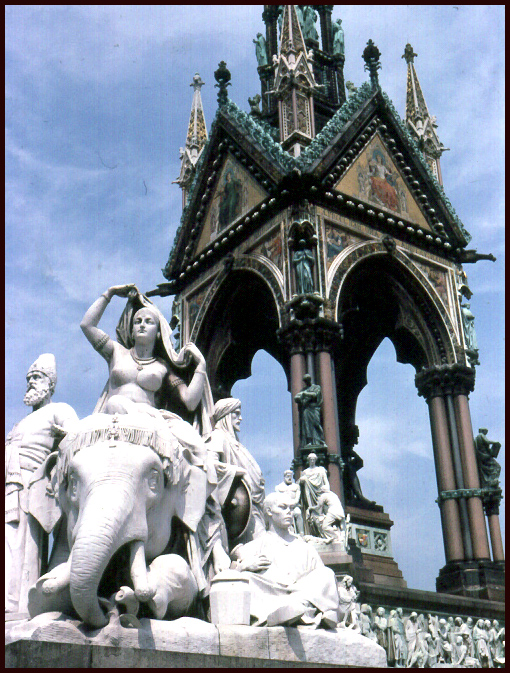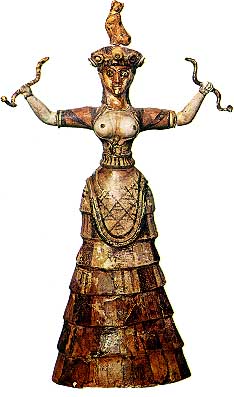
Albert Memorial, Hyde Park, London © 1979, James A. Clapp
A while back, in the Carpe Diem section of this journal I repeated and commented upon a Reuters news item that a Chinese government facility had been pressured to desist in requiring “symmetrical breasts” for its female employees. One of my readers thought it might be one of those Internet hoaxes; but I think not, not if I know a little bit about the Chinese. Anyway, it got me thinking about breasts (although Philip Roth has the literary territory already staked out).
But it is not the first time this subject has come up in these pages. Way back in December of 2003, I posted a travel piece, “Berber Feast,” (Archives 3: 5) an account of an ABG (accidental breast groping) in Morocco some years earlier. The relationship between interest in travel and breasts might be attributed to The National Geographic Magazine , many a young boy’s introduction to faraway places and exposed mammary glands with the alluring combination academic curiosity and adolescent voyeurism.
A few years ago I was traveling in Cambodia, spending several days (it requires several days) in the Angkor Wat complex, founded around the 9 th Century A.D. There was one wall on which there were several life-size reliefs, deep reliefs, of sculpted maidens, perhaps dancers, whatever. They were beautiful, swearing headdresses and sort of hip-hugging pantaloons, but were bare-breasted. They were in a row, perhaps a half-dozen of them, and there were the slightest differences in the features of their smiling faces.
But the left breast on the figure closest to the doorway gleamed with a sheen that was obviously produced by the fondlings of thousands, perhaps tens of thousands, of hands over perhaps a thousand years. I hypothesized that this left breast achieved this gleam because it was closest to the doorway, where a hand could “accidentally” brush across it as one might reach to hold the door jamb on passing through it. Such “ABGs” were also performed by some guys I grew up with who would “cop a feel” while squeezing past an unsuspecting girl on a crowded bus or subway. [2]
Why men, and I am possibly wrong in assuming that it was exclusively men, would want to fondle a stony breast is a curiosity. In this case it might have been at least partially accounted for by the ancient practice of touching something for luck in passing through a doorway, a practice honored by the mezuzah among Jews and the dual-visaged Janus of the Romans. Touching sculpted objects for “luck” is a practice that I have encountered in a variety of places. There is a bronze boar in an open market in Florence whose snout glistens, much as does the paw of a bronze lion in front of the Hong Kong and Shanghai Bank in central Hong Kong. The foot of a statue of St. Peter in his cathedral in Rome and many other statues in churches are touched, rubbed, and sometimes kissed to bestow their magical benefits, [3]and obviously transmit innumerable bacilli and viruses. It seems, then, that there is no reason that the breast might not be a symbol of good fortune in some societies; after all, it was the first food source for so many. So much for anthropology; on to aesthetics. [4]
But this explanation probably also excuses more prurient interests when it comes to shapely parts of female anatomy. To return to the relief maidens of Angkor Wat, my hypothesis is that men find the compulsion to gauge the form of exquisitely-formed breasts almost irresistible, for there is nothing else in Nature that can achieve the perfect form of the human female breast.[5] I am convinced that this form has some eternal and mystical dimensions (though by dimension I am not referring to the obsession of some men with “size”), but, by form, is meant the manner in which the tension between flesh and gravity renders a shape (if transitory, the way a drop of water clings to something by its surface tension) that is incomparable. At its most perfect—the way in which a fruit might be regarded as perfect at the peak of its ripeness—there is no more exquisite form in Nature. When it arrests the attention of a man there are activated urges that can blur the line between the erotic and the mystical, between wantonness and worship, between sustenance and sensuality.
In 1979, while residing in London, my daily morning run was an historical jaunt through Hyde Park and Kensington Gardens. [6] My route took me from the northwest corner, past Kensington Palace (last abode of Princess Diana), over to the Albert Memorial near the southwest corner. There was always a thrill of anticipation in approaching the Albert Memorial. On the four corners of its base, in the center of which is an ornate pavilion decorated in semi-precious stones, over a statue of the Prince, Victoria’s consort and Royal Impregnator, are groupings of oversized statuary that represent the four-corners of the empire on which “the sun never set.” On one corner there is a grouping that I take to represent India, the Middle East and SE Asia. And in that grouping sits a—and there is no more apt word for it—statuesque Indian girl who appears to have been modeled on one of those temple “maidens” that were sculpted to instruct newly-weds in the arts of connubial love. If you have ever seen these deep temple reliefs, you will recall that they are remarkable in their sexual explicitness, but also for the exquisite modeling—approaching mannerist exaggeration—of the breasts of the young women.
But it can also be hypothesized that Miss India of the Albert memorial exhibits the fulsome proportions—those 19 th Century “zaftig,” Rubenseque proportions—that appealed to Victorian tastes, when “bosoms” were the rage. She sits astride an elephant, prominently higher that a Muslim, an Assyrian, and a Far Eastern Asian, her arms raised, giving an open frame and slight “lift” for her elegantly rounded breasts. Oddly, gravity, the arch enemy of the human form in general, and breasts in particular, seems to have had a deleterious pull on even these breasts of stone, as there is an evident fissure (lapidary stretch mark?) above the right breast. But it does not mar the beauty, indeed the majesty, of this marvelous depiction of womanhood, this emblem of the exotic riches and mysterious allure of the East. But I don’t suppose that it would do for one to climb up on this exalted corner of the British Empire and, despite its lack of warmth and elasticity, and just for the briefest of moments, mind you, touch one of those magnificent breasts. Just for luck.

Snake Goddess of Knossos, Heraklion Museum, Crete
___________________________________
©2006, James A. Clapp (UrbisMedia Ltd. Pub. 4.8.2006)
[1] Right off the top I need to say that this is being written by a life-long “leg man,” except when it comes to eating fowl. Why am I writing this? Maybe I have a secret desire for the punishment some of my readers are likely to inflict upon me. But I feel the need to express these thoughts and reminiscences, even though they might not be appropriate for young readers.
[2] No, I was not one of them. Only a few guys I knew did this, and I wonder sometimes what they are doing these days for cheap thrills.
[3] There is, of course the Blarney Stone in Ireland and, inanimate, tough not mineral, the (now lost) toe of St. Francis Xavier from his mummified corpse in the Bom Jesus in Goa.
[4] There is a lot more that could be said about this. There is, for example, the bare-breasted Minoan Snake Goddess of Crete with her magical powers, dozens of Venuses and Aphrodites, the bizarre famous statue of Diana of Ephesus, and the Dolly Parton of Memphis. (Just kidding on this last one. Give me a break , I managed to avoid terminology like “hooters” and such.)
[5] Some would argue that the egg is the perfect form. I have heard of a “leg man” (which I regard myself, in spite of the subject of this essay) but not a single “egg man”.
[6] Which I described in “Running Through History in London’s Hyde Park,” American Running and Fitness , Vol. 15, No. 4, July/August 1983, 8-9.
